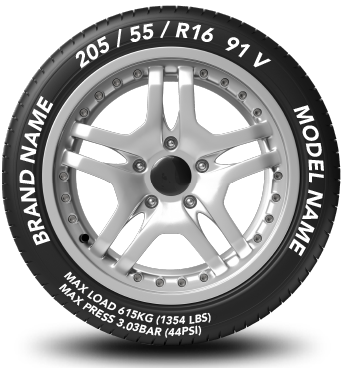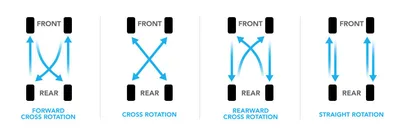
Finding the right tyre
- Share via X
- Share via Facebook
- Share via Pinterest
- Share via LinkedIn
-
Copy to your clipboard
What Are the Best Tyres for Your Car?
Choosing the best tyres for your car depends on many factors. Think about the kind of driving you do, the number of miles you cover and whether you drive a small car through the city or an SUV over long distances. Handling performance, wet grip, noise rating and fuel efficiency all play a part in your decision making too.
What Size Tyres For Your Car?
Tyre size has a direct influence on your car. It is always best to fit the original equipment tyre size so your car handles as it should.
You can find your tyre size in your vehicle handbook or by looking at the sidewall of your current set of tyres. The fitment details on your tyres include:
Width of tyre in millimetres
Profile height of a tyre sidewall as a percentage of the width
The diameter of the wheels inner rim in inches
Load Index indicates the maximum load the tyre can carry
Indicates the maximum speed for the tyre
The model name of the tyre. Unique to each manufacture
Maximum load that the tyre is designed to carry (in both kg and lbs)
Maximum pressure that the tyre is designed to be inflated to (in both bar and psi)
Brand name of the manufacture

Do You Need to Replace all 4 Tyres?
Many people assume you are meant to change your tyres as and when each one reaches the minimum tread depth of 1.6mm. But replacing just one tyre without changing the tyre on the opposite side of the axle may cause an imbalance in your car and that can lead to excessive tyre wear and wheel misalignment.
Some vehicle manufacturers recommend replacing all four tyres at the same time to ensure the car is completely balanced. You can also replace tyres in pairs so they both work optimally together.
Can You Rotate Your Tyres?
You can extend the life of your tyres by rotating them every 6,000 miles or 4,000 miles if you drive a 4x4. How you rotate your tyres depends on the form of engine and transmission layout of the car.
Front wheel drive tyre rotation
Uses a forward cross rotation where the two front tyres are moved to the rear axle and remain on the same side, while the nearside rear tyre becomes your offside front and the offside rear tyre becomes the nearside front.
Rear wheel drive tyre rotation
Uses a rearward cross rotation where the two rear tyres are moved to the front axle and remain on the same side, while the nearside front tyre becomes your offside rear, and the offside front tyre becomes the nearside rear.
Four-wheel drive tyre rotation
Uses a cross rotation where the two rear tyres are moved to the front axle and switched from offside to nearside with the same done for the two front tyres.

Before you consider tyre rotation, it is best to check your vehicle handbook which may contain guidance on changing tyres.
Original Equipment Tyres (OE Tyres)
When you buy a brand-new vehicle straight out of the factory, the tyres fitted on the assembly line are called original equipment tyres. These tyres are chosen by the manufacturer for each make and model of vehicle and they are rigorously tested to meet the strictest performance and safety standards.
You may see premium tyre brand Goodyear on a Ford Focus or Continental on a Mercendez-Benz Sprinter. The tyres and the vehicle are designed together, so continuing to use original equipment tyres will maintain the optimised driving performance the manufacturer intended.
Are Premium Tyres Better than Budget Tyres?
When it comes to buying a new set of tyres for your car, the driving factor behind your decision making may be price. We fit tyres to suit all budgets and driving conditions, but to really understand why we recommend premium brands such as Goodyear and Dunlop we will explain the difference between budget and premium tyres.
Budget Tyres
Budget tyres have a smaller price tag than premium brands. They need to be manufactured to a certain standard by UK law which means they will always meet the minimum safety requirements. But to reflect cost, the materials used in budget tyres can wear quickly and may need to be replaced more frequently which is less economical in the long run.
Premium Tyres
Premium tyres are made by well-known manufacturers and tend to have a higher price tag than budget versions. The cost reflects the research, high-quality materials and rigorous testing that goes into the production of each tyre. Competition between manufacturers is high, so they are constantly adapting and improving their premium range.
Learn more about cheap vs expensive tyres in our blog.
Tyre Label Information
The EU tyre label provides you with important environmental and safety information about your tyres. This information covers fuel efficiency, wet grip and noise rating and can be found on a sticker on the tyre itself. If you cannot find this label please do ask one of our technicians or look at our website for more information.
As of May 2021, The EU tyre label also includes further information on severe snow conditions and ice grip if the tyre is suitable.
Fuel Efficiency
Tyres account for up to 20% of your vehicle’s fuel consumption, so choosing tyres with high fuel efficiency means less CO2 in the atmosphere and more miles from your fuel tank.
Fuel efficiency is graded A-E with A being the highest fuel efficiency rating and E the lowest.
Wet Grip
Tyres with a high wet grip will find it easier to stop quickly on wet roads when the brakes are applied. Wet grip is also graded from A-E with A being the highest rating and E the lowest.
Noise
The EU rating measures the noise emission of the tyre in decibels. The decibel rating will be accompanied by a class scale from A – C.
- A: Quiet (3dB or more below the European limit)
- B: Moderate (between the European limit and 3dB below)
- C: Noisy (above the European limit)
Severe Snow Conditions & Ice Grip
Tyres suitable for severe snow conditions will include the three-peak mountain snowflake symbol. This symbol already appears on the sidewall of suitable tyres. To qualify for the symbol, the tyre will have been tested in severe snow conditions to confirm the tyre passes the winter parameters.
The ice grip symbol indicates that a tyre is suitable for severe ice conditions. To qualify for the symbol, the tyre will have been tested in icy conditions.
Choose The Best Tyres for the Weather
As the weather changes throughout the year, the driving conditions change too. To get the best performance from your tyres you should swap them according to the seasons, however there are all-season tyres that combine the driving characteristics of both summer and winter tyres for a consistent performance in all types of weather all year round.
Summer Tyres
- Fit your wheels with summer tyres when seasonal temperatures reach 7°C and above
- Summer tyres have a hard rubber compound which means they perform best in warmer weather on both dry and wet roads
- They have high stability in curves and optimal mileage performance at warm temperatures
Winter Tyres
- Fit your wheels with winter tyres when seasonal temperatures drop below 7°C
- Winter tyres are softer and have a higher rate of elasticity, so they perform better in lower temperatures
- They are ideal for driving in conditions ranging from wet and cold to snow and ice
All-Season Tyres
- Can be fit to your wheels all year round
- Unique compounds work to maintain rubber elasticity in cold weather, providing better grip and control in adverse conditions
- Do take care if the weather is extreme, especially in more rural areas where a build-up of snow and ice might be more serve
Do I Need Run Flat Tyres?
If you are replacing run flat tyres, you’ll need to fit run flat tyres to your car again.
What is a Run Flat Tyre?
Run flat tyres are designed with a reinforced sidewall to hold the weight of your car when the tyre’s air pressure drops, such as when you get a puncture. Although your vehicle handbook will give you precise guidance on distance and speed, run flat tyres generally should not be driven above 50 mph for more than 50 miles once you’ve had a puncture.
Can You Fit Run Flat Tyres to any Car?
You should only fit run flat tyres on cars specifically equipped for them, there are a couple reasons for this:
Suspension – the car’s suspension is softer to compensate for the hardness of the tyres. The car will handle differently if regular tyres are fitted and that can cause serious safety concerns.
Tyre pressure – cars designed for flat run tyres have an in-built tyre-pressure monitoring system to let you know if a puncture occurs.
What are the Best Tyres for Electric Vehicles?
There were more than 235,000 pure-electric cars on UK roads at the end of March 2021 and with electric cars becoming more popular, it is important to know how their tyres differ from conventional tyres.
Electric car tyres are designed to take the heavier weight from the engine’s battery pack. The increased weight means these tyres need to be more durable to minimise tyre wear, minimise braking distance and provide excellent handling.
Tyre Tread Patterns
If you take a closer look at the tread pattern on each tyre you will see they can be very different, with each tread pattern covering a unique collection of channels, grooves and sipes that provide traction, grip and aquaplane resistance. To know which tread patten is right for your tyre it is important to know the difference between the three tyre tread categories: asymmetric, directional, and multi-directional.
Asymmetric Tread Pattern
Asymmetric tyres mix two different tread patterns on the outer and inner edge of the tyre. The outside edge provides good dry traction while the inside edge provides better wet grip, this means that asymmetric tyres perform well all year round.
Directional Tread Pattern
Directional tyres usually have an arrowhead-like pattern designed to rotate in a single direction. This pattern provides excellent wet weather performance and good directional stability, making them perform well on snow covered roads too.
Multi-directional Tread Pattern
Multi-directional tyres feature a tread block that is the same on the outside and inner side of the tyre which means they can be fitted at any position on the vehicle without loss of performance. This type of tyre tends to be less expensive due to the simpler design, but it also means it is not able to adapt to change as well as the other tread patterns.
Caution: You should never mix and match tyre tread patterns. All tyres need to be the same to ensure they work optimally together.
Where to get Your Tyres Fitted
Ready to get a new set of tyres for your car? Enter your postcode here to find your local HiQ centre.
You can also speak to our expert technicians at our local centres if you would like more guidance choosing the best tyres for your car.